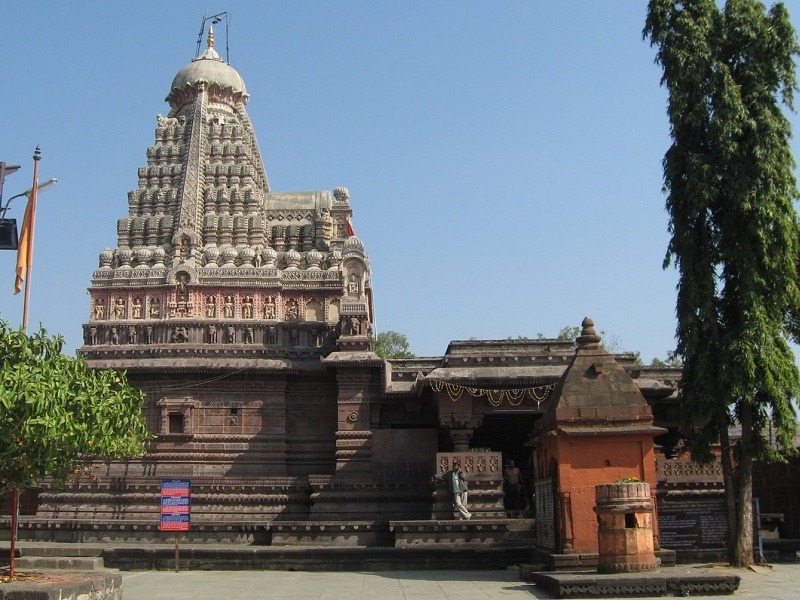Grishneshwar Jyotirlinga Temple is a significant Hindu shrine to Lord Shiva that is situated in the Indian state of Maharashtra close to the city of Aurangabad. It is one of the twelve Jyotirlingas, which are revered as Lord Shiva’s holiest residences. The Grishneshwar Jyotirlinga Temple is described in the following principal details and details
Grishneshwar Jyotirlinga Temple Location
Ellora, known for its rock-cut temples and caves, is home to the Grishneshwar Jyotirlinga Temple. It is conveniently accessible from several areas of Maharashtra and is situated about 30 kilometers from Aurangabad
Lord Grishneshwar, a manifestation of Lord Shiva, is the primary deity of the Grishneshwar Temple. The temple contains a jyotirlinga, a self-manifested lingam (icon) that represents Lord Shiva’s cosmic and limitless nature.
A mythical tale is connected to the temple’s significance. Legend has it that a pious woman by the name of Kusuma prayed and did penance there. Lord Shiva, who was pleased with her devotion, appeared to her as a jyotirlinga, which eventually came to be known as Grishneshwar
Table of Contents
Architecture and Importance
The architecture of Grishneshwar Jyotirlinga Temple is typical of South Indian temples.There are inner chambers and a sanctum sanctorum within the temple structure.The structure is 44,400 square feet in size and is composed of red-colored stones. The Grishneshwar Temple is the smallest Jyotirlinga temple with these proportions as well.
The temple features many pillars with elaborate mythical carvings and a five-layered tall shikhara.The stories of Lord Shiva and the ten incarnations of Lord Vishnu are mostly depicted on the red-stone walls.The Shivalinga in the sanctum sanctorum, also known as the garbhagriha, is facing east. Its footprint is around 289 square feet, and the walkway features a statue of Nandi.
During the Mughal era, the Grishneshwar Jyotirlinga Temple, like many other Hindu temples, encountered difficulties. The temple was demolished by Aurangzeb’s troops, but Ahilyabai Holkar, the monarch of the Maratha Malwa kingdom, eventually reconstructed it.
Although the Grishneshwar Temple’s exact founding date is unknown, it is thought to have been constructed before the 13th century. The temple was destroyed probably in the 13th or 14th century, after the Mughal Empire conquered the area that encompassed Velur (now known as Ellora), where the temple is situated. The area saw several terrible Hindu-Muslim battles during this time.
As the lord of Verul, Maloji Bhosale, the grandfather of Chhatrapati Shivaji Maharaj, was instrumental in the 16th-century reconstruction of the temple. Maloji Bhosale is credited with discovering a secret wealth, which he used to restore the temple and create an artificial lake in Shanishingnapur.
Even after the 16th century, the Mughals continued to attack the Grishneshwar Temple on multiple occasions. It needed to be rebuilt several more times between 1680 and 1707, during the Mughal-Maratha wars. It was reconstructed for the final time in the 18th century following the Marathas’ conquest of the Mughal Empire. The temple that is still visible today was rebuilt thanks to sponsorship from Rani Ahalyabai, the Queen of Indore.
The Grishneshwar Jyotirlinga Temple is a revered destination for Lord Shiva worshipers, drawing travelers from Maharashtra and other regions of India. Maha Shivaratri and other Lord Shiva-related holidays are fervently and devotedly observed.
Festivals and Pilgrimage
A trip to the Grishneshwar Temple is a holy trek to the center of Lord Shiva’s dwelling.Seeking the holy darshan (viewing) of the Grishneshwar Jyotirlinga, a moment of spiritual significance, is a common part of the journey.
The Ghushmeshwar Tirtha Yatra allows pilgrims to explore the area’s hallowed pilgrimage sites connected to Lord Shiva.Grandiose celebrations of Maha Shivaratri draw devotees who participate in prayers, rituals, and processions throughout the night.
During the Kumbh Mela, Grishneshwar transforms into a spiritual centre that attracts pilgrims from all across the nation for a holy gathering.Shravan is a month of increased devotion when followers of Lord Shiva observe special prayers and ceremonies.
Festivals frequently take place in conjunction with regional fairs and melas, fostering a cultural atmosphere and providing pilgrims with a range of experiences.The temple ceremonies are made more culturally rich by the active participation of the local community.
Visitation
Both devotees and tourists are welcome to visit the temple to observe the god and take part in its rites. Before making travel arrangements, it is advised to confirm the temple’s operating hours and regulations.
Tour of Ajanta and Ellora Caves, The Ajanta and Ellora Caves, which display stunning rock-cut sculptures and paintings, frequently include a stop at Grishneshwar Temple.
The Grishneshwar Jyotirlinga Yatra includes the temple as part of its circuit of prominent Maharashtrian Shiva temples.
Also read about Thiruvannamalai Temple.
